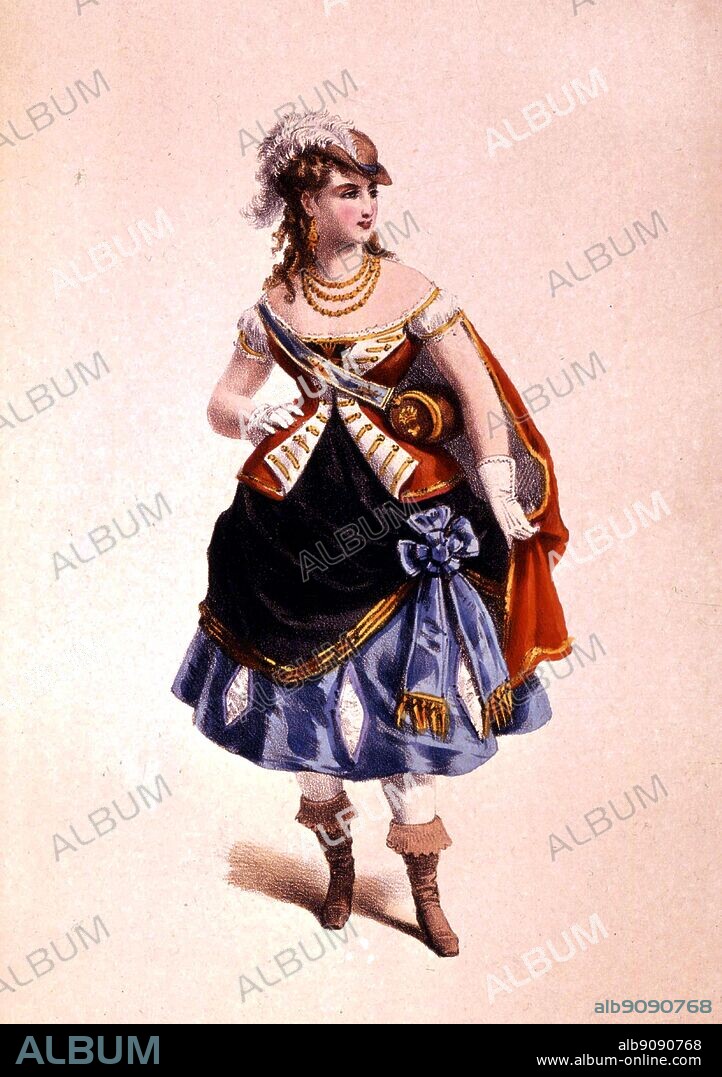alb9090768
Vivandières costume 1860. La Vie Parisienne by Joanna Richardson (1860), page 91. La Vie Parisienne (Parisian Life), composed by Jacques Offenbach (1819-1880), is a five-act opera about cosmopolitan life in Paris in the 1860s. Vivandières (Hospitality giver) played an interesting, and often obscure role in the American Civil War. They travelled with soldiers for little or no pay as sutlers, mascots or nurses, while others fought alongside their male counterparts. Most Vivandières and regimental daughters were mascots, present for parades and reviews but not often seen in battle. Officially during the Civil War, the term Vivandière is usually applied only to women who served with Zouave outfits, and occasionally other ethnic units, since they were official under this title apparently only in France. The term "Vivandière", was officially replaced in 1854 by "Cantinière". During the Civil War, only women travelling with the Garibaldi Guard appear to have been called Cantinières, though even they were referred to more often as Vivandières. Many Vivandières carried a trademark cask, either round or oval, often filled with brandy or wine. Their uniforms generally consisted of jackets copied from those of their units, many times with feminine touches such as extra braid or lace. They wore men's trousers under a knee-length skirt and many Vivandières had trousers which were sewn in two sections with wool starting at the hemline, so that they appeared to be wearing the same wool trousers as their male companions.

|
Añadir a otro lightbox |
|
Añadir a otro lightbox |



¿Ya tienes cuenta? Iniciar sesión
¿No tienes cuenta? Regístrate
Compra esta imagen

Descripción:
Ver traducción automática
Vivandières costume 1860. La Vie Parisienne by Joanna Richardson (1860), page 91. La Vie Parisienne (Parisian Life), composed by Jacques Offenbach (1819-1880), is a five-act opera about cosmopolitan life in Paris in the 1860s. Vivandières (Hospitality giver) played an interesting, and often obscure role in the American Civil War. They travelled with soldiers for little or no pay as sutlers, mascots or nurses, while others fought alongside their male counterparts. Most Vivandières and regimental daughters were mascots, present for parades and reviews but not often seen in battle. Officially during the Civil War, the term Vivandière is usually applied only to women who served with Zouave outfits, and occasionally other ethnic units, since they were official under this title apparently only in France. The term "Vivandière", was officially replaced in 1854 by "Cantinière". During the Civil War, only women travelling with the Garibaldi Guard appear to have been called Cantinières, though even they were referred to more often as Vivandières. Many Vivandières carried a trademark cask, either round or oval, often filled with brandy or wine. Their uniforms generally consisted of jackets copied from those of their units, many times with feminine touches such as extra braid or lace. They wore men's trousers under a knee-length skirt and many Vivandières had trousers which were sewn in two sections with wool starting at the hemline, so that they appeared to be wearing the same wool trousers as their male companions.
Crédito:
Album / TopFoto
Autorizaciones:
Modelo: No - Propiedad: No
¿Preguntas relacionadas con los derechos?
¿Preguntas relacionadas con los derechos?
Tamaño imagen:
2477 x 3513 px | 24.9 MB
Tamaño impresión:
21.0 x 29.7 cm | 8.3 x 11.7 in (300 dpi)
Palabras clave:
ACTOR DRAMATICO • ACTOR • ACTRIZ • ARTES ESCENICAS • CAPA (ROPA) • CHAQUETA • COLLAR • COMEDIA MUSICAL • COMPOSITOR FRANCES • DIVERSION • EJECUTANTE • ENTRETENIMIENTO • FRANCESES • FRANCIA • GENTE • GORRO • GRAN BRETAÑA • GUANTE • GUANTES • MODA • OPERETA • REFAJO • RETRATOS • ROPA • SIGLO XIX • TEATRAL • TEATRO • TEATROS • UNIFORME • VESTUARIO DE TEATRO
 Pinterest
Pinterest Twitter
Twitter Facebook
Facebook Copiar enlace
Copiar enlace Email
Email
